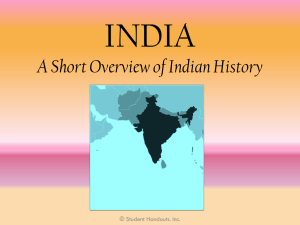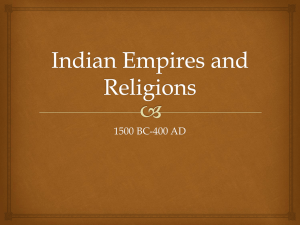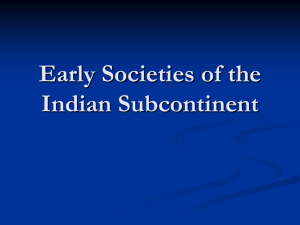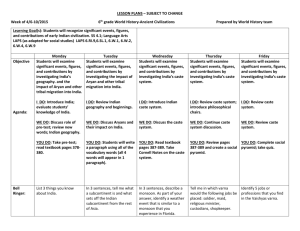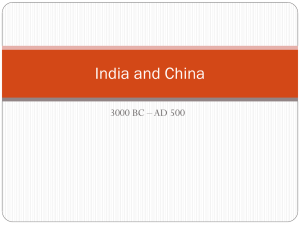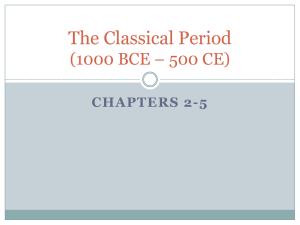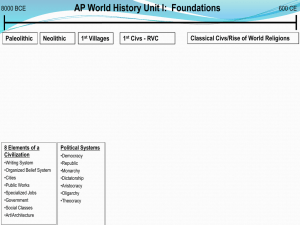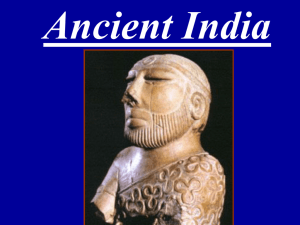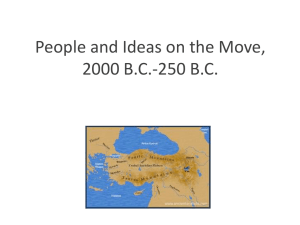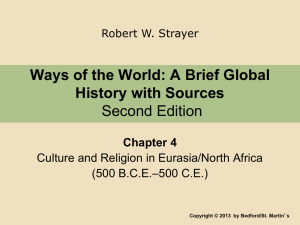India - Brookdale Community College
advertisement
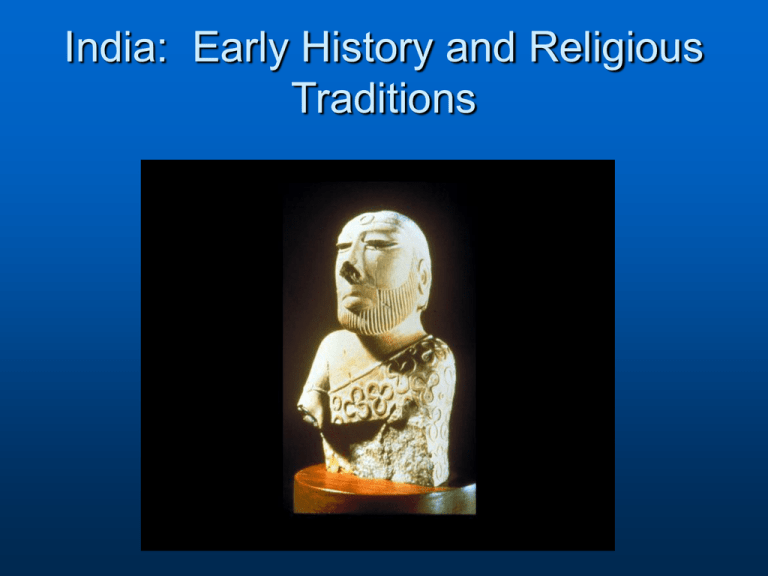
India: Early History and Religious Traditions What did the early complex societies of India and China share in common? What are some differences between early Indian and Chinese societies? India - “gift of the Indus” Northern India: Indus valley Southern India: The Deccan Indo-Gangetic Plain Geography and India Semi –isolation: More open to outside influences Two main areas • Indo –Gangetic Plain – soil most fertile • Deccan Plateau –higher and dryer Climate: The Monsoon Monsoons Major Themes of Indian History Diversity—Language, Religion, Custom A “Nation of Shopkeepers” Major success in manufacturing – especially textiles like cotton Constant invasion! Outsiders attracted by trade and wealth Not a tradition of political unity like China “Fabric” of Indian Society woven together with Hinduism and caste Chronology of Early Indian History c. 2500 BCE: Indus Valley civilization c. 1900 BCE: Harappan decline c. 1500 BCE: Beginning of Aryan migration 1500-500 BCE: The “Vedic Age” 520 BCE: Darius of Persia invades India 327 BCE: Alexander the Great invades India 321-185 BCE: Mauryan dynasty 320-550 CE: Gupta dynasty Harappan Civilization Est. 3000-2500 B.C.E. Two major cities: Harappa & Mohenjodaro At least 70 other smaller settlements Settled by the Dravidians Mohenjo-daro in the ancient world Mohenjo-daro Other artifacts from Harappan sites Priest-king? Mohenjo-daro Sandstone The “Dancing Girl” Mohenjo-daro Bronze Harappan seals Mesopotamia Egypt Indus China Mediterranean Central America Fossil Fuel Civ. Aryan arrival in India: Conquest or Migration? Nomadic Aryans arrived over many centuries Rig Veda describes conflict with indigenous peoples Over time, established agricultural communities, cities, small kingdoms and intermingled with Dravidians Aryan Migrations: Four Consequences New Language – Sanskrit New Religious Ideas – Vedas New Techniques of Warfare New Social Organization - Caste The Indo-European Migrations Aryan migration into Indian sub-continent: 1500 B.C.E. - How do we know about the IndoEuropean migrations? Sanskrit Aryan writing system brought with them from Indo-European steppe Oldest living language Same origins as Greek and Latin “raja” -> “rex” – king in Latin “deva” -> “deus” – god in Latin Unrelated to Dravidian languages Linguistic evidence of I-E Migrations Similarities among some Indo-European languages: FATHER: English father German vater Spanish padre Greek pater Latin pater Sanscrit pitar Alexander the Great invades 327 bce Invasion of India inspires political unfication Emergence of the Mauryan Empire Most Famous Leader-Ashoka “ideal leader” Mauryan Empire 321-185 BCE Ashoka –268 – 232 BCE Applied Buddhist principles to government “Ahimsa”nonviolence Built roads, hospitals, rest houses and reduced animal slaughter Period of great Ashoka’s Rock Pillars Gupta “Golden Age” 320-550ce Gupta “Golden Age” Arts and Sciences Fully Developed • • • Math- zero, “Arabic numerals, infinity” Hindu classics refined- “Indian Shakespeare”-Kalidasa; Buddism also important Nalanda University Trade with Southeast Asiabeginning of “Southernization” 40º North The “Vedic Age”: 1500-500bce Named for sacred texts, the “Vedas” Period important for: • Assimilation of Aryans • Emergence of varna distinctions • Emergence of The Rig Veda in Sanscrit Caste / Varna System of social distinctions probably created by Aryans Distinctions were based on occupations and roles in society Varna = class or caste Jati = sub-caste What is Caste? “A caste is a group of families whose members can marry with each other and can eat in each other’s company without believing themselves polluted. . .Each of these has its place in a hierarchy. . .above, or below, or equal to, every one of the others; and in theory everybody knows where each groups comes.” RGH #32, p. 109 Traditional Varnas Brahmin Priests Kshatriyas Warriors and aristocrats Vaishyas merchants Cultivators, artisans, Shudras Servants ___________________________________ Outcastes “Untouchables” Why does caste emerge? “cradle to grave security” Village Caste Family From the Rig Veda: When they divided Purusha, how many portions did they make? What do they call his mouth, his arms? What do they call his thighs and feet? The BRAHMIN was his mouth, of both his arms was the KSHATRIYA made. His thighs became the VAISHYA, and from his feet the SHUDRA was produced. Dharma of Women From “Sacred Law of Dharma” 100bce-200ce “Her father protects her in childhood, her husband protects (her) in youth, and her sons protect (her) in older age; a woman is never fit for independence” “Though destitute of virtue, or seeking pleasure (elsewhere), or devoid of good qualities, (yet) a What is varna today? See RGH #34-37 Varna ISN’T: Class Color Aryan vs. non-Aryan Occupation- Varna IS: “A group of families whose members can marry each other and can eat in each other’s company without believing themselves polluted.” Taya Zinkin “ranked, named, endogamous [inmarrying], with membership achieved by birth” TE: Throughout Indian history, caste has promoted “social stability” Since 1949 Untouchability is illegal India’s constitution forbids discrimination based on caste India has caste-based “positive discrimination” programs Yet caste remains important in social life: who one can marry, or eat and socialize with Mohandas Gandhi What Brings Happiness? pleasure and enjoyment work and fame duty and service being, awareness, joy Hinduism Oldest religion that is still widely practiced A fusion of Aryan and Dravidian beliefs-very diverse Unique among world religions: • No founder • No centralized authority Indra Emergence of Hinduism The Vedas 1400-900 BCE: • Ritual and sacrifice solely by priestly class The Upanishads 800400 BCE: • Individual is responsible for his/her own salvation The Bhagavad Gita 300 BCE-300 CE: • Salvation possible through a balanced life and by fulfilling one’s Hanuman Concepts introduced in the Upanishads and the Bhagavad Gita (Song of God): Brahman: “the universal soul” Everyone and everything is part of Brahman Each person possesses an atman, part of Brahman “I am the beginning, middle, the end of creation” Samsara: reincarnation The cycle of death and rebirth Karma: Law of “as you sow, so shall you reap” One’s present situation is the product of deeds done in a previous life For every action there is a consequence Dharma – moral and caste duty Moksha: release from reincarnation Artha: •Pursuit of economic well-being and honest prosperity Kama: •Enjoyment of social, physical, sexual pleasure Yoga: •Union with Brahman Moksha: •Attainable through proper balance of these. Namaste Yoga: Union with Brahman Sannyasin – Holy Men Puja Table Worship Hindu pantheon: combination of Vedic and indigenous gods: Avatars: incarnations of god Brahma – Creator God Vishnu – Preserver God Shiva Vishnu’s Avatar: Krishna Shiva – Destroyer God Ganesh: Vishnu’s Avatar Hindu Wheel of Life Varna and Hinduism Varna is legitimized in Rig Veda Hindu concepts uphold and reinforce varna Samsara explains one’s present caste and offers hope of better incarnation in next life “Fulfilling one’s duties” = fulfilling the duties of one’s caste “Do your dharma and you’ll get good karma” Jainism Mahavira is the founder rejected caste ahimsa = nonviolence Buddhism Founded by Siddhartha Gautama [b. 563 B.C.E.] Shared many concepts with Hinduism But also reacted against many Hindu ideas, including caste Principles of Buddhism Four Noble Truths: All life is suffering (dukkha) Suffering is caused by desire To stop suffering, stop desiring Stop desiring by following the Eight-Fold Path Nirvana – “extinction of desire” BUDDHA UNDER THE BODHI TREE Principles of Buddhism Nirvana – “the extinction of Desire” Two Major Sects of Buddhism • Hinayana “Lesser Vehicle” – monasticism-retreat from the world • Mahayana “Greater Vehicle” – bodhisattva Buddhism as a World Religion The Spread of Buddhism and Hinduism The many shapes and faces of the Buddha Five Stages of Buddhism “Old” Buddhism – 500100 bce philosophy emphasized Hinayana – “Lesser Vehicle” monasticism “save yourself through intense selfBOUDHANATH WITH MONKS, effort” NEPAL Popular in Tibet, Sri Five Stages of Buddhism Mahayana – “Greater Vehicle”100bce-500ce • bodhisattva – emphasis on compassion (See RGH #44, p. 131) and “saving others” • blending of Buddhism with Greek philosophy • Buddha begins to be worshipped like a god • Education – Nalanda U. – center of learning • Popular in Japan, China, the world. The many shapes and faces of the Buddha Why was (is?) Buddhism attractive? message appealed to lower castes and women. used common language, not Sanskrit. pilgrimage and holy sites emphasized. wealthy patrons, like Ashoka. “Buddhism ZEN BUDDHISTS MEDITATING IN KENTUCKY (1997) The Dalai Lama in conversation with U.S. President George W. Bush at the White House Great Stupa of Dharmakaya in Colorado "American Buddhist with Thai Buddha", Living Enrichment Center, Wilsonville, Oregon, 1998. 40º North Main Themes in South Asia Islam comes to India: Role of merchants, missionaries (Sufis), and the military. Kingdoms in South Asia: Chola Cross-cultural trade in the Indian Ocean: India the “Workshop of the World.” Indianized states in Southeast Asia: Funan, Srivijiva, Angkor Islam in Southeast Asia: Melaka Trading world of Indian Ocean Basin, 600-1600 CE Fine Spice Trade Nutmeg Mace Cloves Trading world of Indian Ocean Basin, 600-1600 CE Malaysia Malay sailors Balanced lug sails Monsoon winds Prototype for Arab lateen sail and European boats
